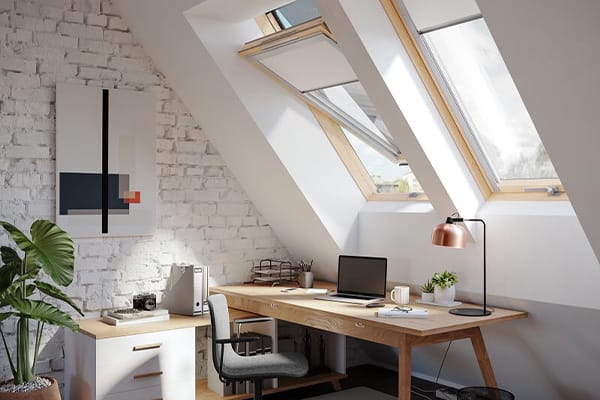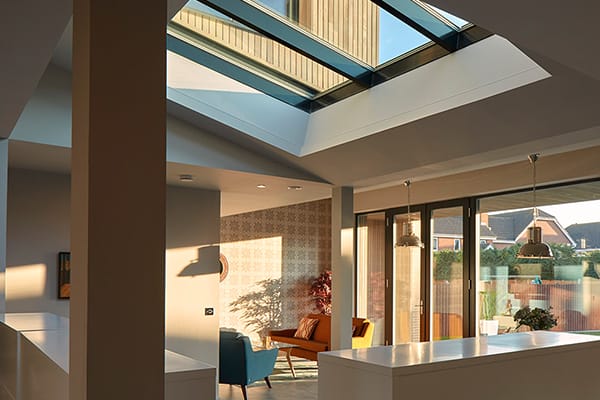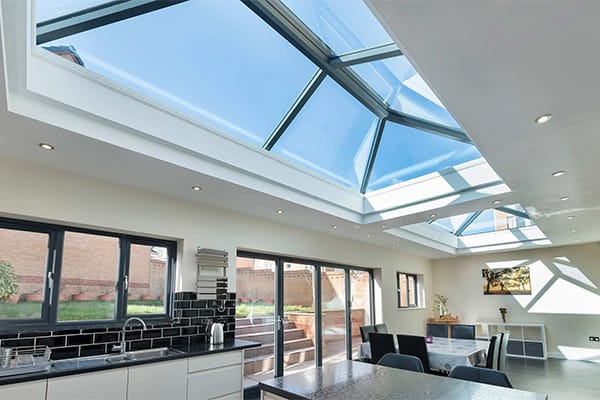How Skylights Improve Energy Efficiency
Skylights change a building’s energy balance in three big ways:
- They reduce lighting demand.
Daylight from above penetrates deeper than light from vertical windows, so rooms stay usable without artificial lighting for more hours each day. That’s the most immediate boost to skylight energy efficiency zero watts is cheaper than even the most efficient LEDs.
- They can add useful passive heat in winter.
Sunlight (short-wave radiation) passes through glass and becomes gentle warmth indoors. With the right g-value (solar factor) and orientation, energy-efficient skylights trim heating demand on clear days.
- They limit unwanted heat loss when specified correctly.
Low-E coatings, argon or krypton gas fills, warm-edge spacers and thermally broken frames lower the rooflight thermal performance number (whole-window U-value). Airtight installation then protects that performance in the real world.
Put simply: the right glass + the right detailing + the right placement = brighter rooms, fewer lighting hours, and moderated heating/cooling needs.
What is the Most Effective Skylight for Energy Efficiency

There’s no one-size-fits-all, but the best skylight for energy efficiency usually looks like this:
- Whole-window U-value (Uw) around 1.0–1.2 W/m²K (or lower for high-performance new builds). Always compare whole-window data, not centre-pane figures.
- Balanced g-value chosen to orientation:
- South/West: 35–0.45 to limit summer gains.
- North/East: 0.50+ to keep spaces bright with cool, diffuse light.
- High visible light transmittance (VT) typically ≥ 60 % for primary daylit spaces.
- Thermally broken frame with continuous insulation at the upstand or reveal.
- Airtightness safeguarded by tapes/gaskets that connect the frame to the vapour control layer.
- Laminated inner pane for safety and comfort (warmer interior surface = less edge condensation; quieter rooms too).
Glazing choice:
- High-spec double glazing (low-E + argon + warm-edge spacer) can hit Uw ≈ 1.2 W/m²K.
- Triple glazing adds comfort and pushes Uw toward/below 1.0 W/m²K—handy on north-facing roofs, exposed sites or bedrooms where radiant chill is noticeable.
Skylight Design Features for Maximum Energy Efficiency
To turn lab numbers into real-world savings, design for performance and behaviour.
1) Put light where it saves the most
Place the aperture over the task (island, dining, desk, sofa). A smaller, well-placed opening often saves more lighting energy than a larger, poorly positioned one.
2) Split big areas into multiple modest openings
Two or three coordinated rooflights give smoother illuminance and less glare than one giant pane and they’re easier to crane, flash and air-seal.
3) Tune g-value and shading to the roof pitch/orientation
- Solar-control coatings with internal or external blinds keep summer comfort in check.
- Ridge or dual-aspect glazing admits balanced light from both sides of the roof, reducing contrast and artificial lighting hours.
4) Vent smart, cool smart
Opening rooflights above kitchens and bathrooms enable rapid purge ventilation that drops humidity and perceived temperature without resorting to energy-hungry cooling. Add automation (temperature/humidity/rain sensors) so the system works even when you forget.
5) Detail for airtightness and thermal continuity
- Carry the air barrier up to the frame with compatible tapes; seal corners meticulously.
- Insulate internal reveals to prevent cold-edge condensation.
- Keep drainage/weep paths clear so water never sits against seals.
6) Choose frames that match the brief
- Thermally broken aluminium for slim sight-lines and durability.
- Timber for warm interiors (accept higher maintenance).
- Hybrid (timber inside / aluminium outside) for a balanced approach.
Energy-efficient Skylights vs. Traditional Windows

Both deliver daylight, but they behave differently.
Daylight effectiveness
- Rooflights admit higher illuminance deeper into a plan, because the sky vault is the primary light source. That can cut lighting hours more than an equivalent façade window.
Solar gains
- On south/west elevations, vertical glazing can deliver strong, low-angle gains that overheat interiors. Skylights on sloped roofs receive a different sun path; choose a lower g-value and shading to capture winter warmth yet limit summer spikes.
Thermal losses
- A modern rooflight with Uw ≈ 1.0–1.2 W/m²K performs similarly to a good window; the difference is installation risk. Poorly detailed upstands or flashings create bypasses that erase performance. Get the detail right and rooflights are competitive on heat loss while outperforming on daylight.
Ventilation strategy
- A high rooflight paired with a low opening sets up stack-effect airflow often more effective for purge ventilation than a single façade window.
Conclusion of the comparison: If you’re chasing lighting savings and balanced comfort, energy-efficient skylights can out-perform traditional windows per square metre of opening provided they’re specified and installed with airtightness, shading and orientation in mind.
Buying & Specifying Tips (So the Efficiency Shows Up On Site)

- Insist on whole-window data. Ask suppliers for Uw/g/VT that include the frame. Centre-pane numbers flatter performance and can mislead.
- Prioritise installation quality. A perfect IGU with a leaky upstand is a poor performer. Budget time and materials for tapes, membranes and insulated reveals.
- Plan shading/controls up front. Internal blinds, external shades or electrochromic options keep summer comfort in check; energy-efficient skylights need control as much as good glass.
- Use laminated inner panes. Better safety and typically warmer interior glass surface temperatures = fewer edge-condensation complaints.
- Document and hand over. Commission sensors, demonstrate blinds, and provide a simple care sheet so occupants use the system optimally.
Also read: Best Skylight Brands in the UK
Maintenance That Protects Performance
Small habits lock in the energy gains:
Clean glass and frames quarterly with pH-neutral products to maintain light transmittance; avoid abrasives that scuff coatings.
Keep drainage/weep holes clear so water can’t sit against seals (critical on flat roofs).
Inspect sealants and gaskets annually for UV cracking or compression set; renew before heavy weather.
Exercise openers & test sensors monthly so purge ventilation is available on hot or humid days.
Control indoor humidity in winter to reduce condensation that looks like a “leak” but isn’t use extract, timed venting, and reasonable indoor RH targets.
Common Pitfalls (and Quick Fixes)
- Chasing the lowest U-value only. Balance Uw with g-value and VT; a super-low g can make rooms dim in winter, leading to more artificial light.
- Using the wrong comparison data. Always compare *whole-window* to *whole-window*.
- Oversizing a single aperture.Large panes can create glare and patchy light; multiple moderate skylights deliver better visual comfort and similar energy gains.
- Ignoring airtightness.Performance leaks at corners and interfaces tape and seal methodically.
- No plan for cleaning/blinds.If occupants can’t reach controls or glass, they won’t use the system well.
Conclusion and Recommendations

Energy efficiency from skylights isn’t a happy accident it’s a design you can engineer:
- Right glass: low-E, gas fill, warm-edge spacers; triple where comfort or exposure demands it.
- Right balance: g-value and VT tuned to orientation and use, with blinds or external shading for resilience.
- Right placement: put light over tasks, split across openings for even spread, and use high-low openings for stack-effect cooling.
- Right detailing: airtight tapes, insulated reveals, matched flashing/kerb systems and clear drainage.
- Right handover: controls commissioned, users briefed, maintenance plan in place.
Follow that blueprint and energy-efficient skylights deliver bright, comfortable rooms that feel larger and cost less to run without compromising aesthetics.
Ready to specify?
SM GlassTech designs, manufactures and installs high-performance rooflights fixed, opening, conservation, modular and walk-on engineered for measurable skylight energy efficiency.
FAQ:
How Do I Choose the Right Size Skylight for My Space to Maximize Energy Savings?
- Start with purpose. If the aim is to replace daytime electric lighting over a task, size the aperture to deliver comfortable lux there often 10–20 % of floor area as glazing, split across two openings for even spread.
- Check structure and access. Oversized single panes may need cranage; modular runs are lighter, easier to seal, and simpler to maintain.
- Mind glare. Bigger isn’t always better pair moderate VT with blinds and a tuned g-value for comfortable light without hot spots.
Can Energy-Saving Skylights Be Installed in Both Residential and Commercial Buildings?
Yes. The principles are the same rooflight thermal performance (Uw), solar control (g-value/shading), and airtight detailing. Commercial projects often add daylight controls (sensors dim artificial lighting automatically) for measurable kWh savings; homes benefit most from targeted placement and purge ventilation.
Can I Install Energy-Efficient Skylights in Any Type of Roof or Only Certain Types?
- Flat roofs: use an insulated upstand (typically ≥ 150 mm above finished roof) and manufacturer-matched waterproofing details. Keep drainage paths clear.
- Pitched roofs: select flashing kits matched to tile/slate/metal profiles. Many pitched roof windows rotate for safe indoor cleaning great for upper storeys.
- Accessible roofs: if anyone can step near a unit, confirm the glazing is non-fragile to the appropriate class, or specify a rated walk-on skylight. (That’s an energy topic too walk-ons bring daylight below without sacrificing the terrace above.)







